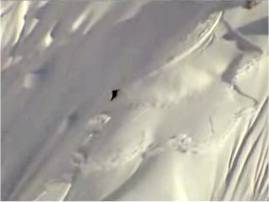Conventional wisdom says that if you are caught in an avalanche swim for your life to stay on the surface but according to avalanche expert Dale Atkins it is wisdom that may kill you. According to Dale the swimming technique was first described by a French survivor back in 1864 and has been oft repeated since. Before joining Swedish firm Recco as a consultant Dale spent for nearly twenty years as a senior avalanche forecaster at the Colorado Avalanche Information Center in Boulder and has done time as a ski patroller and rescue worker.
Dale agrees with the basic idea is that a human body is denser than snow but says that an avalanche is a granular flow not liquid and what matters is volume. Small particles settle on the bottom while larger objects remain on the surface. Try shaking a potato chip bag if you don’t believe him, the crumbs and broken crisps can be found at the bottom of the bag. It is the same theory behind the successful ABS Avalanche Airbag. Technically it is called inverse segregation but Dale prefers the “Brazil nut effect” because smaller nuts sink to the bottom of the cereal bowl.
Over the last 30 years 1748 people were caught in avalanches in the United States but only 18% (309) were buried. Those figures exclude less serious incidents that go unreported. Dale estimates the real burial figure to be closer to 10%. Atkins says that the most important thing to do if buried is to maintain a breathing space around your mouth. In twenty years of investigating incidents and nearly three decades of pulling bodies out of the snow Dale says the most striking factor was no breathing space and hands a long way from the face. If victims are frantically flailing with their arms it is hard to make a space in the second when the slide comes to a rapid halt and solidifies. Victims have described how they could not even open their eyelids due to the pressure of the snow, it was as if entombed in concrete.
The most important thing is to get rid of anchors such as ski poles (you shouldn’t have pole loops anyway) and skis but to keep your rucksack - it adds volume and helps protects your back if carried over rocks or cliffs. Although many survivors describe how they swam to stay on the surface Atkins says it was their volume, not swimming, that really kept them afloat and compares the advice to a course of leeches, if people survive the doctors claim that the leeches did the trick.
At PisteHors we’ve long been dubious about the swimming theory. If you are caught in a hard slab avalanche you have little control over events but in a softer slab getting rid of anchors seems to be the most important factor followed by trying to make an airspace or get an arm above the slide as it comes to a stop. Survivors have told us that “the swimming advice obviously comes from people who have never been caught in an avalanche”, that they felt like a “rag doll in a washing machine”.
Posted by
davidof on Monday, 22 January, 2007 at 04:14 PM
I have been caught once in a slab that was like the earlier correspondent described, a bit like the glazing on a plate that has been hit with a hammer.( Christmas day 2004)
I skied straight down and stayed ontop for about 80/100m then when the terrain changed into more of a funnel the snow started to come at me from 3 different directions, it stopped me dead and started to pile up all around me.
My skis stayed on, and they were a big anchor. When my lower body was trapped, since I do not use straps I was able to use my hands to clear a space in front of my face, but in a microsecond my right arm was trapped by moving snow and I could not free it. Luckily by that time the slide had pretty well stopped and I was in the bizarre position of being almost completely immobilised with snow almost to the top of my chest and unable to free myself, but with my left hand free, I was able to call on my walkie talkie to the rest of my team that I was safe and could they come and dig me out!!
BTW it was on a 2/5 day. Four much bigger, heavier guys had each gone acroos the slope before me, and we were each separated by at least 50m.
Generally, my sense is get rid of everything that will pull you in/down ie skis /poles. I have never used my pole straps since tree skiing in Canada, catch a pole in a branch and rip your shoulder off ??
Posted by on Wednesday, 31 January, 2007 at 06:27 PM

